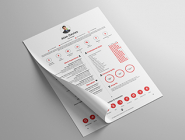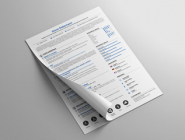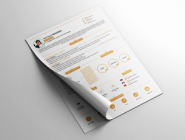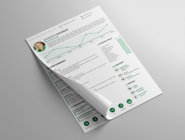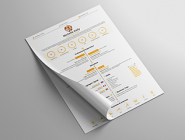
A resume, as it is only between 1 to 2 pages long, can seem deceptively straight forward, but when you consider that it is perhaps the most important part of most job applications you put forward, it can make the process of writing one a little intimidating. Your resume is essentially your story of your history on a professional level to prospective employers.
So, how do you write a resume? If you are looking for resume help, you've come to the right place.
Primarily, your resume should be clear, concise, consistent and very easy to read. If it doesn't meet this primary criteria it will never make it to a hiring manager's desk.
If this is the first resume you have ever written or you want to make sure you do a better job this time, in the following post we will look at how to write a killer resume that will make you stand out and help secure interviews.
Choose Resume Format
You may want to try out different kinds of resume templates. There are various types of resume to choose from when applying for work and it will depend on your own circumstances. The most commonly used formats are targeted, combination, functional and chronological. By far the most effective you could choose and the one employers seem to like the most is the chronologically laid out resume.
What To Include In Your Resume
Obviously the most important thing about your resume and the thing many people get wrong is not giving careful consideration to what you need to include in each of the sections of resume.. To help you put together a great resume, you will find will find below a guide to what exactly you should include and where, as well as some advice about things like formatting and font etc.
Include Resume Keywords
Nowadays, most companies and recruitment agencies use specialist recruiting management software to effectively screen prospective candidates for job openings.Therefore to ensure you are found and your resume is ever read, your resume should include “keywords” that will target specifically the kind of work you are interested in doing.
Sections of Resume
Your resume should include the following sections. You may ommit some of the optional sections.
1. Personal Information/Identification
You should include your full name, address, telephone number, Skype ID, email address and anything else you feel is relevant in the personal information section. It is important that you remember to use your professional email address rather than your non-work related one, as it will look better. Your personal information should appear at the top of the resume.
2. Resume Objective (Optional)
It is not essential for your resume to have an objective, but if you do decide to include one make sure it is to the point and very concise. All it needs to show is the field or job you want to work In, why and what you aim to accomplish within that field.accomplish in that field.
3. Profile (Optional)
Another section that is not necessary but can be a great addition if you want to summarise your goals, experiences and skills with the specific job vacancy you are applying for in mind.
4. Education
When you fill out the education section of your resume you should start by including any degrees you have received in chronological order, listing the most recent degree awarded first and working backwards. It is also important that you include the name of each university/institution, the location and date (or expected date) of your graduation.
Where and if it is applicable you should also include the major and minor fields, as well as the GPA and any honours, publications and projects you completed as part of your degree.Unless you are still at high school, you should avoid including any information regarding your high school education.
5. Work Experience
You should list your work experience in chronological order, starting with the most recent first and working backwards. As well as jobs, this section can also include jobs, intern-ships, volunteer work and high school students may wish to include sports teams and other club memberships and activities if it is relevant to the job you are applying for.It is crucial that you include the full name of the company you worked for, the position you held at that company and how long you were employed by them.
Without going into too much detail, you then need to list at least 3 important skills, accomplishments or tasks you completed/gained at each job. Although you may not think it is important, but you need to pay attention closely to your grammar and be sure to avoid passive phrases such as “duties include” and “responsible for”, instead, using action verbs to describe your accomplishments.
6. Skills
This is another section that may or may not be useful depending on the range of skills you have, whether you have already highlighted these in another section or if they are applicable to the role you are applying for.
If you do decide to include a skills section, you may want to mention any computer skills you have, such as the computer systems you are proficient working with.
List any foreign languages you may have familiarity with, remembering to include the language and level you understand and can communicate it at (beginning, intermediate, proficient and fluent – for example)
List any other skills you may have that are relevant to the job, but have not been mentioned anywhere else in the resume.
7. Volunteer Work
Again, another optional section – especially if you have already listed voluntary positions you have held in the work experience section of the resume. You may wish though, to highlight and convey your communication skills, leadership skills etc. Include the name of the organisation you volunteered for and any achievements/accomplishments you achieved during your time with the organisation.
8. Interests And Hobbies
If there are some interests and hobbies you would like to mention as they are relevant to the position, and have not been included anywhere else, you should add them here. e.g. If you were applying to work in a sports centre, swimming pool, gym or sports equipment and goods store, you may wish to include your interest in basketball/soccer etc.
Some Resume Guidelines To Keep In Mind
Resume Length
As your resume should not be long like a CV, it should be kept as concise as possible and should be no longer than 2 pages. Although, one page is preferred.
Font And Size
While you may be tempted to use a fancy font for your resume to make it stand out and individualise it a little from the rest of the pile on a prospective employer's desk, you should avoid using these as they can be easy to read. If your prospective employer finds it too difficult to read your resume, they will likely abandon reading it altogether.
Therefore, it is highly recommended you use a nice and clear font such as Calibri, Ariel or Times New Roman to name a few. The size should be around 10 to 12 points, though you can make your name and section headings bigger and bold them.
Margins
The standard page margin in most word processing software is 1 on the top, bottom, right and left sides of the page. This works well for resumes. If you find you need to reduce the length of your resume, you can do this by decreasing the margins to ½ on each side, bottom and top.
Information You Should Avoid Including
We have spoken at length about the information you SHOULD include, but there is some information your prospective employer won't want to read. This includes:
- Your birthday
- Heigh
- Weight
- Marital status
- Number of children you have
- And other similar things.
You should only include any of the above if it is relevant in some way to the job/position.
Our resume builders make the whole process of making the CV painless. You can just feed in your information in the design of your choice and download your CV as PDF.

